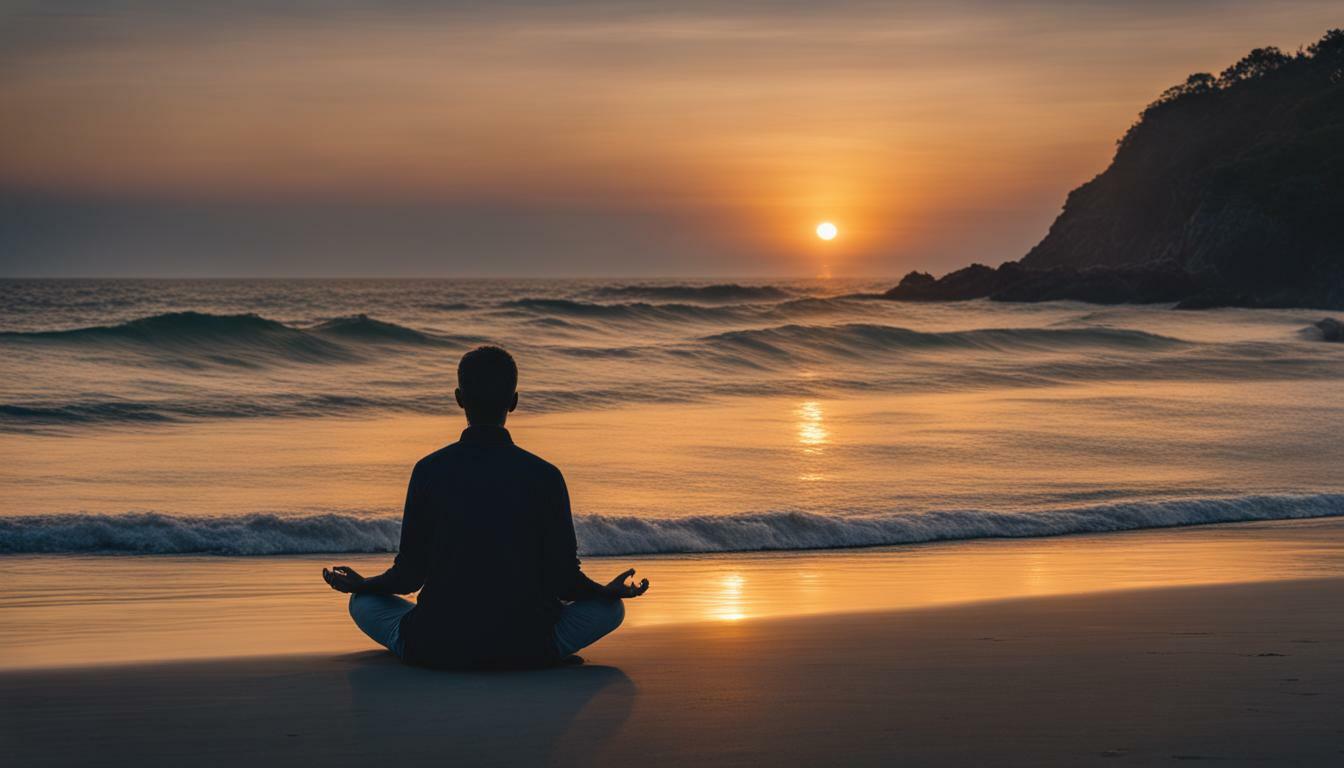If you’re looking to reduce stress and find serenity in your daily life, practicing mindfulness and meditation can be incredibly beneficial. Mindfulness is the ability to be fully present and aware of our thoughts, emotions, and physical sensations. It can be practiced through meditation and by bringing awareness to daily activities. The goal is to bring attention to the present moment without judgment. Mindfulness meditation involves focusing on the breath or bodily sensations and returning to them when the mind wanders. It’s important to be kind to oneself and not judge thoughts or emotions that arise during meditation. Mindfulness can be practiced in various ways, such as body scans or mindful moment practices throughout the day. There are also guided meditations available for different purposes, such as reducing stress, cultivating mindfulness, or promoting sleep. Mindfulness meditation has been shown to have numerous benefits, such as reducing stress and anxiety, improving focus and concentration, and cultivating compassion and kindness. It is recommended to start with short meditation sessions and gradually increase the duration. Mindfulness courses and programs are widely available and have gained popularity in various settings, including schools, workplaces, and the military.
Key Takeaways:
- Mindfulness is the practice of being fully present and aware of thoughts, emotions, and physical sensations.
- Mindfulness can be practiced through meditation and by bringing awareness to daily activities.
- Mindfulness meditation involves focusing on the breath or bodily sensations.
- Mindfulness has numerous benefits, including reducing stress and anxiety, improving focus and concentration, and cultivating compassion and kindness.
- Starting with short meditation sessions and gradually increasing the duration is recommended.
Understanding Mindfulness and Meditation
Before diving into the practice of mindfulness and meditation, it’s important to understand their benefits and have some tips to get started. Mindfulness is the ability to be fully present and aware of our thoughts, emotions, and physical sensations. By practicing mindfulness, we can bring attention to the present moment without judgment, cultivating a sense of clarity, calmness, and self-awareness.
Mindfulness meditation is one of the ways to practice mindfulness. It involves focusing on the breath or bodily sensations and returning to them whenever the mind wanders. During meditation, it’s essential to be kind to ourselves and not judge the thoughts or emotions that arise. It’s about observing them with curiosity and allowing them to pass without attachment. Regular mindfulness meditation can have numerous benefits, including reducing stress and anxiety, improving focus and concentration, and cultivating compassion and kindness.
If you’re new to mindfulness and meditation, here are a few tips to get started:
- Find a quiet and comfortable space where you can sit or lie down without distractions.
- Set a timer for your meditation session, starting with just a few minutes and gradually increasing the duration as you become more comfortable.
- Take deep breaths, focusing on the sensation of the breath entering and leaving your body.
- Allow thoughts and emotions to arise without judgment, acknowledging them and gently bringing your attention back to the breath.
- Consider using guided meditations or apps that offer mindfulness exercises tailored to your needs and goals.
Remember, mindfulness and meditation are practices that require patience and consistency. By incorporating them into your daily routine, you can experience the transformative benefits they offer.
| Mindfulness Benefits | Mindfulness Practice Tips | Meditation Techniques for Beginners |
|---|---|---|
| – Reduces stress and anxiety | – Find a quiet and comfortable space | – Start with short meditation sessions |
| – Improves focus and concentration | – Set a timer for your meditation session | – Focus on the breath or bodily sensations |
| – Cultivates compassion and kindness | – Take deep breaths | – Practice non-judgment and curiosity |
Mindfulness Meditation Techniques
There are different techniques and practices that can enhance your mindfulness meditation experience and help you reap its many benefits. One simple yet powerful technique is mindful breathing. This involves focusing your attention on each breath, noticing the sensation of the breath entering and leaving your body. As thoughts or distractions arise, gently bring your focus back to the breath. This practice can help calm the mind, reduce stress, and increase present-moment awareness.
Another technique is body scan meditation. This involves systematically bringing your attention to different parts of your body, starting from the top of your head and moving down to your toes. Notice any sensations or tensions in each area, without judgment or the need to change anything. This practice can promote relaxation and body awareness.
Guided meditations are also valuable tools for mindfulness practice. These are audio recordings or apps that provide instructions and guidance throughout the meditation. They often focus on specific themes, such as self-compassion, stress reduction, or gratitude. Guided meditations can be especially helpful for beginners or those who prefer structured guidance.
To get started with mindfulness meditation, find a quiet and comfortable space where you can sit or lie down. Set a timer for your desired meditation duration, starting with just a few minutes and gradually increasing over time. Experiment with different techniques and find what works best for you. Remember, the goal is not to empty the mind of thoughts but to observe them without judgment. With regular practice, mindfulness meditation can enhance your well-being and bring greater clarity and peace into your daily life.
| Technique | Benefits |
|---|---|
| Mindful Breathing | Calms the mind, reduces stress, increases present-moment awareness |
| Body Scan Meditation | Promotes relaxation, enhances body awareness |
| Guided Meditations | Provides structured guidance, helps cultivate specific qualities or states of mind |
Incorporating Mindfulness into Daily Life
Mindfulness is not just limited to formal meditation sessions; it can be integrated into your daily life through specific exercises and practices. By incorporating mindfulness into your everyday activities, you can experience greater peace, clarity, and well-being.
One way to practice mindfulness in daily life is through mindful breathing exercises. Take a few moments throughout the day to focus on your breath, allowing yourself to fully experience each inhale and exhale. This simple practice can help calm your mind, reduce stress, and bring you back to the present moment.
Another technique is to cultivate mindfulness during routine activities. For example, when you’re eating a meal, pay attention to the flavors, textures, and sensations of each bite. Slow down and savor every moment, fully engaging your senses. This practice of mindful eating can not only enhance your enjoyment of food but also promote healthier eating habits.
| Mindfulness Exercise | Description |
|---|---|
| Mindful Walking | Take a walk in nature and focus on the sensations in your body, the sounds around you, and the beauty of your surroundings. |
| Mindful Listening | During conversations, practice active listening by fully focusing on the speaker without interrupting or formulating a response in your mind. |
| Mindful Gratitude | At the end of each day, reflect on three things you are grateful for. This simple practice can cultivate a sense of appreciation and positivity. |
Incorporating mindfulness into your daily life doesn’t have to be time-consuming or complicated. It’s about bringing your full awareness and presence to whatever you’re doing, whether it’s brushing your teeth, driving, or spending time with loved ones. By practicing mindfulness consistently, you can enhance your overall well-being and enjoy a greater sense of peace and fulfillment.
Finding Resources and Furthering Your Practice
To deepen your mindfulness and meditation practice, there are various resources available such as courses and programs specifically designed to support your journey. These resources can provide guidance and structure as you continue to explore and develop your mindfulness skills. Whether you are a beginner or have been practicing for some time, these offerings can help you deepen your understanding and enhance your practice.
1. Mindfulness Courses
Attending a mindfulness course can be a valuable way to learn and practice mindfulness in a supportive environment. These courses often cover various mindfulness techniques, provide opportunities for guided meditation, and offer insights from experienced instructors. Many courses are available online, allowing you to participate from the comfort of your own home and at your own pace. Look for courses that align with your interests and needs, whether that’s cultivating mindfulness in relationships, reducing stress and anxiety, or exploring mindfulness in the workplace.
2. Mindfulness Programs
Mindfulness programs offer a more comprehensive and immersive experience for those looking to dive deeper into their mindfulness practice. These programs typically span a longer duration and may include retreats, workshops, and ongoing support. They provide an opportunity to fully immerse yourself in the practice and connect with a community of like-minded individuals. Whether you prefer a residential program or an online format, there are various options available to cater to different preferences and schedules.
By engaging in mindfulness courses or programs, you can gain a deeper understanding of mindfulness and meditation, learn new techniques, and receive guidance from experienced practitioners. These resources provide a structured framework to support and nurture your practice, helping you cultivate mindfulness in all aspects of your life.
| Benefits of Mindfulness Courses and Programs | Features |
|---|---|
| 1. Enhanced Learning | – In-depth knowledge of mindfulness techniques – Expert guidance and feedback – Opportunities for interactive discussions and Q&A sessions |
| 2. Community and Support | – Connect with like-minded individuals – Share experiences and insights – Foster a sense of belonging and support |
| 3. Structured Approach | – Clear progression and curriculum – Consistent practice and accountability – Access to resources and materials |
| 4. Flexible Options | – Online or in-person formats – Various program lengths and intensities – Tailored to different skill levels and interests |
Conclusion
By incorporating mindfulness and meditation into your routine, you can experience greater serenity, reduced stress, and an overall improvement in mental and emotional well-being.
Mindfulness is the practice of being fully present and aware of our thoughts, emotions, and physical sensations. It can be cultivated through meditation and bringing mindfulness to daily activities. The goal is to bring attention to the present moment without judgment, allowing us to better understand ourselves and the world around us.
Through mindfulness meditation, we can focus on the breath or bodily sensations and gently return to them when the mind wanders. It’s important to be kind to ourselves, acknowledging any thoughts or emotions that arise without judgment. There are various ways to practice mindfulness, such as body scans or mindful moments throughout the day.
Guided meditations are also available for different purposes, such as reducing stress, cultivating mindfulness, or promoting better sleep. These meditations provide support and guidance, helping us navigate the practice and reap its benefits.
The benefits of mindfulness meditation are vast. Research has shown that it can reduce stress and anxiety, improve focus and concentration, and promote feelings of compassion and kindness. Starting with short meditation sessions and gradually increasing the duration is recommended, allowing us to build resilience and deepen our practice over time.
Fortunately, there are many resources available to support our mindfulness and meditation journey. Mindfulness courses and programs have gained popularity in various settings, including schools, workplaces, and the military. These resources can provide structured guidance and knowledge, helping us further develop our practice and integrate mindfulness into our daily lives.
By embracing mindfulness and meditation, we can foster a greater sense of well-being and live more fully in the present moment. Take the time to explore different techniques and resources, finding what works best for you. With dedication and practice, you can cultivate a mindful way of living that brings peace, clarity, and joy.
What Is the Best Way to Start Practicing Meditation and Mindfulness?
When it comes to beginning a meditation practice, there are a few key steps to consider. First, find a quiet and comfortable space where you can sit or lie down without distractions. Focus on your breath and slowly become aware of your surroundings. Gradually allow your thoughts to pass without judgment. With consistent practice, you can cultivate mindfulness and experience the positive effects of meditation.
FAQ
Q: What is mindfulness?
A: Mindfulness is the ability to be fully present and aware of our thoughts, emotions, and physical sensations.
Q: How can I practice mindfulness?
A: Mindfulness can be practiced through meditation and by bringing awareness to daily activities.
Q: What is the goal of mindfulness?
A: The goal of mindfulness is to bring attention to the present moment without judgment.
Q: What is mindfulness meditation?
A: Mindfulness meditation involves focusing on the breath or bodily sensations and returning to them when the mind wanders.
Q: How should I approach thoughts and emotions during meditation?
A: It’s important to be kind to oneself and not judge thoughts or emotions that arise during meditation.
Q: How can I practice mindfulness throughout the day?
A: Mindfulness can be practiced in various ways, such as body scans or mindful moment practices throughout the day.
Q: Are there guided meditations available?
A: Yes, there are guided meditations available for different purposes, such as reducing stress, cultivating mindfulness, or promoting sleep.
Q: What are the benefits of mindfulness meditation?
A: Mindfulness meditation has been shown to have numerous benefits, such as reducing stress and anxiety, improving focus and concentration, and cultivating compassion and kindness.
Q: How should I start practicing mindfulness meditation?
A: It is recommended to start with short meditation sessions and gradually increase the duration.
Q: Where can I find mindfulness courses and programs?
A: Mindfulness courses and programs are widely available and have gained popularity in various settings, including schools, workplaces, and the military.








